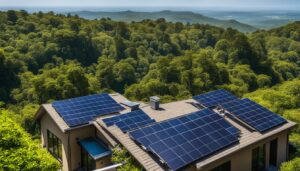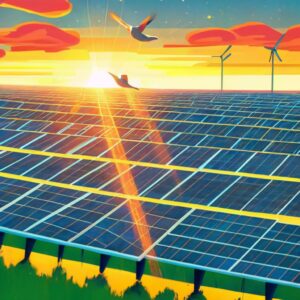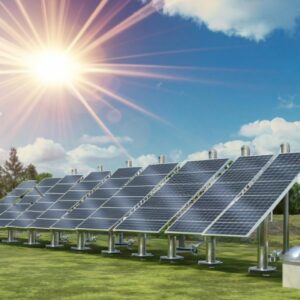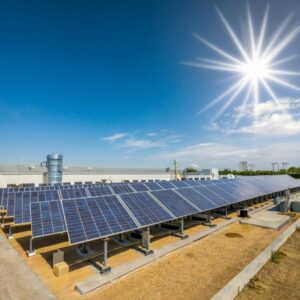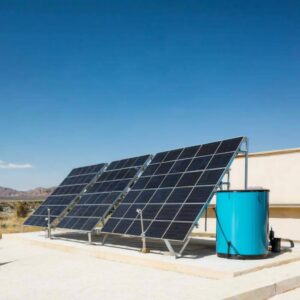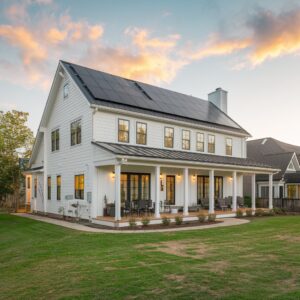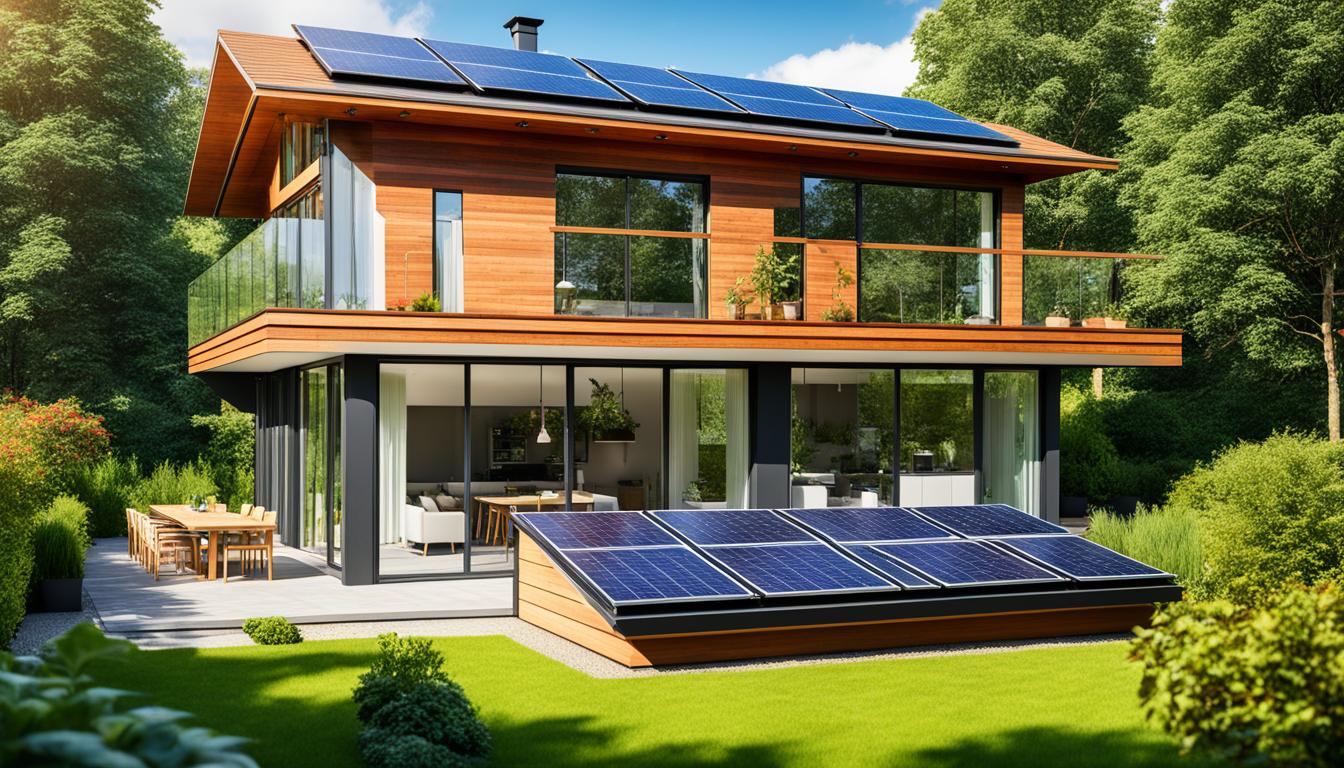
As an eco-conscious homeowner, I am always looking for ways to reduce my carbon footprint and lower my energy costs. One of the most effective and sustainable solutions I have discovered is integrating solar power into my home design. Solar power has come a long way in recent years, making it easier than ever to seamlessly incorporate solar panels into a green home design. Not only does this decision promote a more eco-friendly lifestyle, but it also offers numerous benefits in terms of energy efficiency and cost savings.
Solar power integration in eco-friendly home design is a win-win situation. By harnessing the power of the sun, I can significantly reduce my reliance on traditional energy sources and contribute to a greener future. Moreover, the advancements in technology and design mean that solar panels can now be seamlessly integrated into various architectural styles, from modern to traditional, without compromising the aesthetic appeal of the home.
Key Takeaways
- Solar power integration is an essential aspect of eco-friendly home design.
- Solar power reduces reliance on traditional energy sources and lowers energy costs.
- Solar panels can be seamlessly integrated into different architectural styles.
- Integrating solar power adds value to your home and promotes sustainability.
- Consultation with professionals is crucial to ensure optimal solar panel placement.
The Advantages of Solar Power in Eco-Friendly Home Design
Solar power offers numerous advantages in the context of eco-friendly home design. By harnessing the power of the sun, homeowners can significantly reduce their reliance on traditional energy sources, leading to lower energy bills and a smaller carbon footprint.
Solar power also provides a reliable and renewable source of energy, ensuring a continuous supply throughout the year.
Additionally, the integration of solar panels adds value to the home and enhances its sustainable image.
Lower Energy Bills and Reduced Carbon Footprint
By utilizing solar power, homeowners can tap into a free and abundant energy source, significantly reducing their reliance on the grid. This translates into substantial savings on monthly energy bills, freeing up funds for other expenses. Moreover, solar power produces clean energy by converting sunlight into electricity, resulting in a smaller carbon footprint and contributing to a greener environment.
Reliable and Renewable Energy
Unlike conventional energy sources, solar power relies on an abundant resource that is available throughout the year – the sun. This means homeowners can enjoy a continuous supply of electricity while reducing their dependence on finite fossil fuels. Solar panels work silently and efficiently, producing energy from sunlight without any noise or emissions, further enhancing their appeal in eco-friendly home design.
Increased Property Value and Sustainable Image
Integrating solar panels into the design of an eco-friendly home not only provides tangible benefits but also boosts the property’s value. Solar-powered homes are highly sought after in today’s market, as they represent a sustainable and forward-thinking choice. By embracing solar power, homeowners showcase their commitment to environmental responsibility and position their property as a sustainable investment.
In conclusion, the advantages of solar power in eco-friendly home design are undeniable. From cost savings to environmental benefits, solar power integration offers a sustainable and efficient solution for homeowners. By taking advantage of this renewable resource, individuals can create a greener future while enjoying the long-term advantages of clean and reliable energy.
Factors to Consider When Integrating Solar Power into Your Home Design
When integrating solar power into your home design, there are several important factors to consider. These considerations will ensure that your solar panel system is efficient, effective, and seamlessly integrated into your home’s design. By taking these factors into account, you can maximize the benefits of solar power and create a sustainable and energy-efficient living space.
Assessing Available Roof Space and Orientation
One of the first considerations is to assess the available roof space and orientation of your home. Solar panels require direct sunlight to generate electricity effectively. It is crucial to evaluate your roof’s exposure to sunlight throughout the day and throughout the year. A south-facing roof is generally ideal for maximum solar energy generation. Additionally, you need to ensure that your roof is structurally sound and can support the weight of the solar panels.
Determining the Size and Type of Solar Panel System
The size and type of solar panel system you choose depends on your household’s energy needs and available space. Consider your typical electricity usage and how much of that you want to offset with solar power. A professional solar contractor can help you determine the appropriate system size based on your energy consumption patterns. Additionally, you can choose between traditional solar panels or more innovative designs, such as solar roof tiles or solar shingles, which blend seamlessly with your home’s architecture.
Researching Local Regulations and Obtaining Permits
Before installing a solar panel system, it is crucial to research the local regulations and obtain any necessary permits. Different municipalities may have specific guidelines regarding the installation of solar panels, including placement, height restrictions, and aesthetic considerations. Consulting with local authorities or a solar professional can help you navigate the permitting process and ensure compliance with local regulations.
Budgeting for the Initial Investment and Considering Maintenance
Integrating solar power into your home design requires an initial investment. It is important to budget for the cost of solar panels, inverters, batteries, and installation services. The price of a solar panel system varies depending on factors such as system size, brand, and specific requirements. While the upfront cost may seem significant, it is essential to consider the long-term savings on energy bills and potential government incentives. It is also important to consider the maintenance requirements of solar panels, including periodic cleaning and inspection.
By carefully considering these factors when integrating solar power into your home design, you can ensure a successful and rewarding solar panel installation. An optimized solar panel system will provide long-term energy savings, reduce your carbon footprint, and contribute to a more sustainable future.
The Cost of Integrating Solar Power into Your Home Design
When considering the integration of solar power into your home design, the cost is an important factor to consider. The overall cost can vary depending on various factors such as the size of the system, the chosen brand, and specific requirements unique to your home. The initial investment typically ranges from $10,000 to $50,000, which includes the purchase and installation of solar panels, inverters, batteries, and other necessary components.
However, it’s vital to note that the cost of solar power integration has significantly decreased in recent years. This reduction, coupled with long-term energy savings, makes solar power a more affordable option in the long run. Additionally, there may be potential government incentives and tax credits available to further offset the cost of installation.
By investing in solar power integration, you not only contribute to a more sustainable future but also reduce your reliance on traditional energy sources, leading to significant cost savings over time.
Here is a breakdown of the potential costs involved in integrating solar power into your home design:
| Cost Component | Estimated Cost |
|---|---|
| Solar Panels | $5,000 – $20,000 |
| Inverters | $1,500 – $5,000 |
| Batteries | $3,000 – $10,000 |
| Installation | $1,500 – $5,000 |
| Permits and Inspections | $500 – $2,000 |
| Total | $10,500 – $42,000 |
“Investing in solar power integration not only contributes to a more sustainable future but also reduces your reliance on traditional energy sources, leading to significant cost savings over time.”
While the initial investment may seem substantial, the long-term benefits and energy savings associated with solar power integration outweigh the upfront costs. It’s crucial to explore financing options, government incentives, and consult with professionals to determine the best solution for your specific home design and budget.
The Process of Installing Solar Panels in an Eco-Friendly Home Design
Installing solar panels in an eco-friendly home design involves several steps that ensure a safe and efficient integration of renewable energy. As a homeowner, it’s essential to follow a systematic approach to maximize the benefits of solar power. Here is an overview of the installation process:
- Consultation and Assessment: The first step is to consult with professionals who can conduct a thorough assessment of the roof’s suitability and orientation for solar panel installation. They will evaluate factors such as roof condition, shading from nearby structures or trees, and the optimal tilt and direction for maximum sunlight exposure.
- Design and Placement: Based on the assessment, the design and placement of solar panels are determined. This includes determining the number of panels required to meet the household’s energy needs and deciding on the best layout to optimize energy production.
- Installation: Once the design is finalized, the installation process can begin. It is crucial to hire qualified installers who have experience in solar panel installation. They will mount the panels securely on the roof and ensure proper wiring and grounding to connect them to the electrical system.
During the installation process, it is important to adhere to local regulations and codes to ensure compliance. Using licensed and certified professionals guarantees that the installation is done safely and efficiently.
Installing solar panels is a significant investment that requires careful planning and execution. By following these steps and seeking professional guidance, homeowners can seamlessly integrate solar power into their eco-friendly home design.
See the table below for a summary of the installation process:
| Step | Description |
|---|---|
| Consultation and Assessment | Professionals assess the roof’s suitability and orientation for solar panel installation. |
| Design and Placement | The number of panels and their optimal layout are determined based on the assessment. |
| Installation | Solar panels are securely mounted on the roof and connected to the electrical system. |
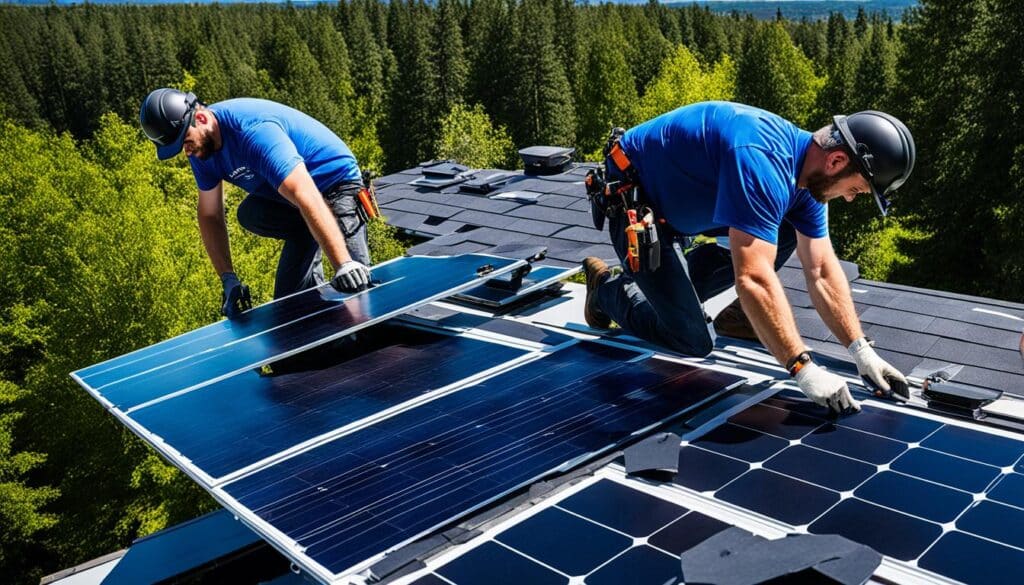
Maintenance and Optimization of Solar Power in Eco-Friendly Home Design
After the installation of solar panels in an eco-friendly home design, regular maintenance is crucial to ensure optimal performance and longevity. Solar power maintenance plays a vital role in maximizing the benefits of this sustainable energy source. Here are some essential steps to keep your solar power system in top condition:
Maintenance Tips:
- Clean the panels regularly: Remove dirt and debris from the panels using a soft brush or cloth. This helps maintain maximum sunlight absorption and prevents any obstructions that could affect the overall performance.
- Check electrical connections: Inspect the electrical connections to ensure they are secure and free from any damage. Loose or faulty connections can reduce the efficiency of the system and potentially pose safety risks.
- Monitor performance: Keep track of your solar power system’s performance by monitoring the energy production regularly. This allows you to identify any potential issues or inefficiencies early on and take appropriate action.
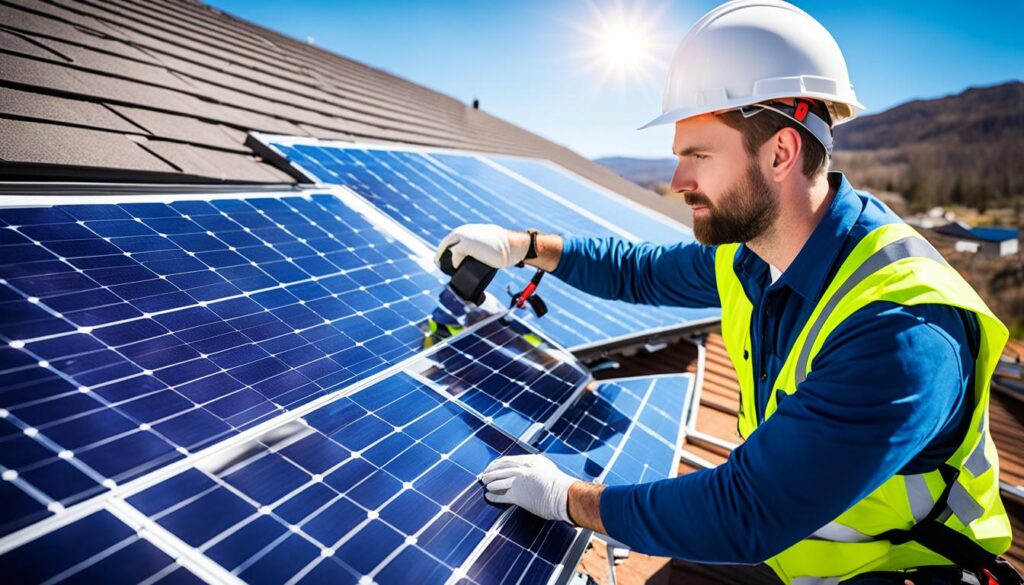
Optimization Techniques:
To maximize the benefits of solar power integration, consider implementing the following optimization techniques:
- Embrace energy-efficient practices: Complement your solar power system with energy-efficient appliances and lighting. This reduces overall energy consumption and maximizes the usage of solar-generated electricity.
- Utilize smart technologies: Install smart energy management systems that allow you to monitor and control your energy usage effectively. These systems can provide valuable insights and help optimize energy consumption based on your specific needs and preferences.
By focusing on regular maintenance and optimization efforts, you can ensure the long-term efficiency and sustainability of your solar power system, contributing to a greener and more eco-friendly home design.
Conclusion
Integrating solar power into your eco-friendly home design offers numerous benefits. By harnessing the power of the sun, you can significantly reduce your energy costs and lower your carbon emissions. Additionally, incorporating solar panels into your living spaces increases the value of your property, making it a wise investment for the long term.
To seamlessly integrate solar panels, proper planning, budgeting, and consultation with professionals are essential. Assessing your available roof space and orientation, determining the size and type of solar panel system, and ensuring compliance with local regulations are crucial factors to consider. By taking these steps, you can optimize sunlight exposure and successfully incorporate solar power into your eco-friendly home design.
Regular maintenance and optimization efforts are key to ensuring the long-term efficiency and sustainability of your solar power system. It is important to clean your panels regularly, check the electrical connections, and monitor the system’s performance. By implementing energy-efficient practices and utilizing smart technologies, you can further optimize solar power usage and maximize the benefits of your eco-friendly home design.
In conclusion, embracing solar power integration not only contributes to a greener and more energy-efficient future but also allows you to enjoy the benefits of clean and renewable energy. With proper planning, installation, and maintenance, you can create an eco-friendly home design that is both sustainable and cost-effective. Make the switch to solar power and take a step towards a brighter and greener future.
FAQ
What are the benefits of integrating solar power into an eco-friendly home design?
By integrating solar power, homeowners can reduce their energy bills, lower their carbon footprint, and increase the value of their home.
What factors should be considered when integrating solar power into a home design?
Homeowners should assess available roof space and orientation, determine the size and type of solar panel system, research local regulations, and budget for the initial investment and maintenance requirements.
How much does it cost to integrate solar power into home design?
The cost varies depending on factors such as the size of the system, brand, and specific requirements. The initial investment can range from ,000 to ,000, but the cost of solar power has significantly decreased in recent years.
What is the process for installing solar panels in an eco-friendly home design?
Homeowners should consult with professionals to assess roof suitability and orientation, design and place the solar panels, and hire qualified installers for safe and efficient installation.
How do I maintain and optimize solar power in an eco-friendly home design?
Regular maintenance includes cleaning the panels, checking electrical connections, and monitoring system performance. Homeowners can optimize usage through energy-efficient practices and smart technologies.
What are the advantages of solar power in eco-friendly home design?
Solar power reduces reliance on traditional energy sources, provides a continuous supply of renewable energy, and enhances the sustainable image of a home.
Source Links
- https://www.chemistryworld.com/news/making-green-steel-from-red-mud/4018865.article
- https://www.theguardian.com/global-development/2024/jan/30/low-carbon-milk-to-ai-irrigation-tech-startups-powering-latin-americas-green-revolution
- https://www.iol.co.za/dailynews/news/solar-installation-tips-for-homeowners-a3d854a0-68d2-4e5a-9ea0-2f7bf298c493


